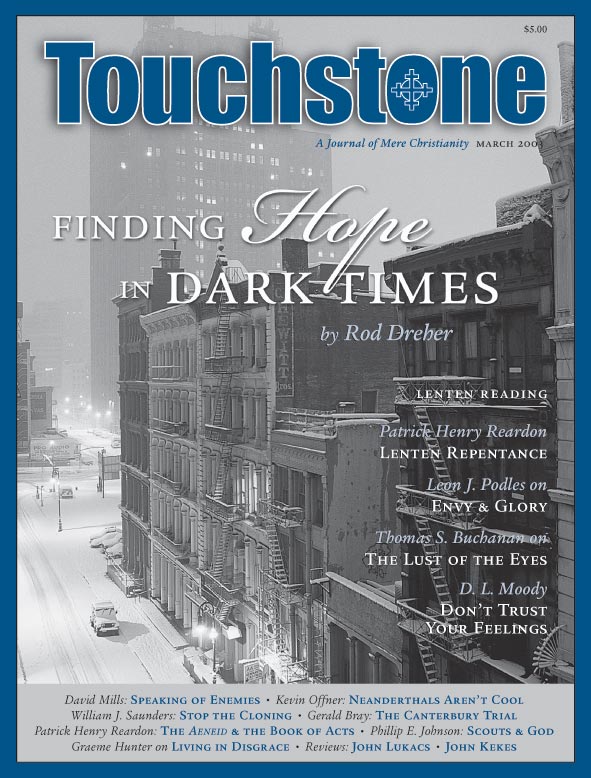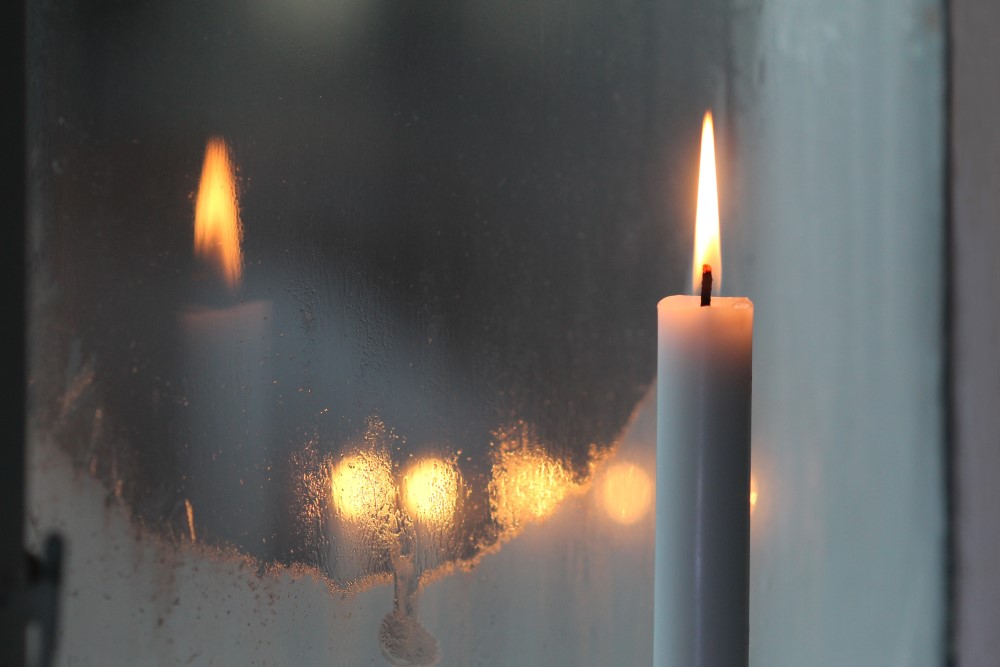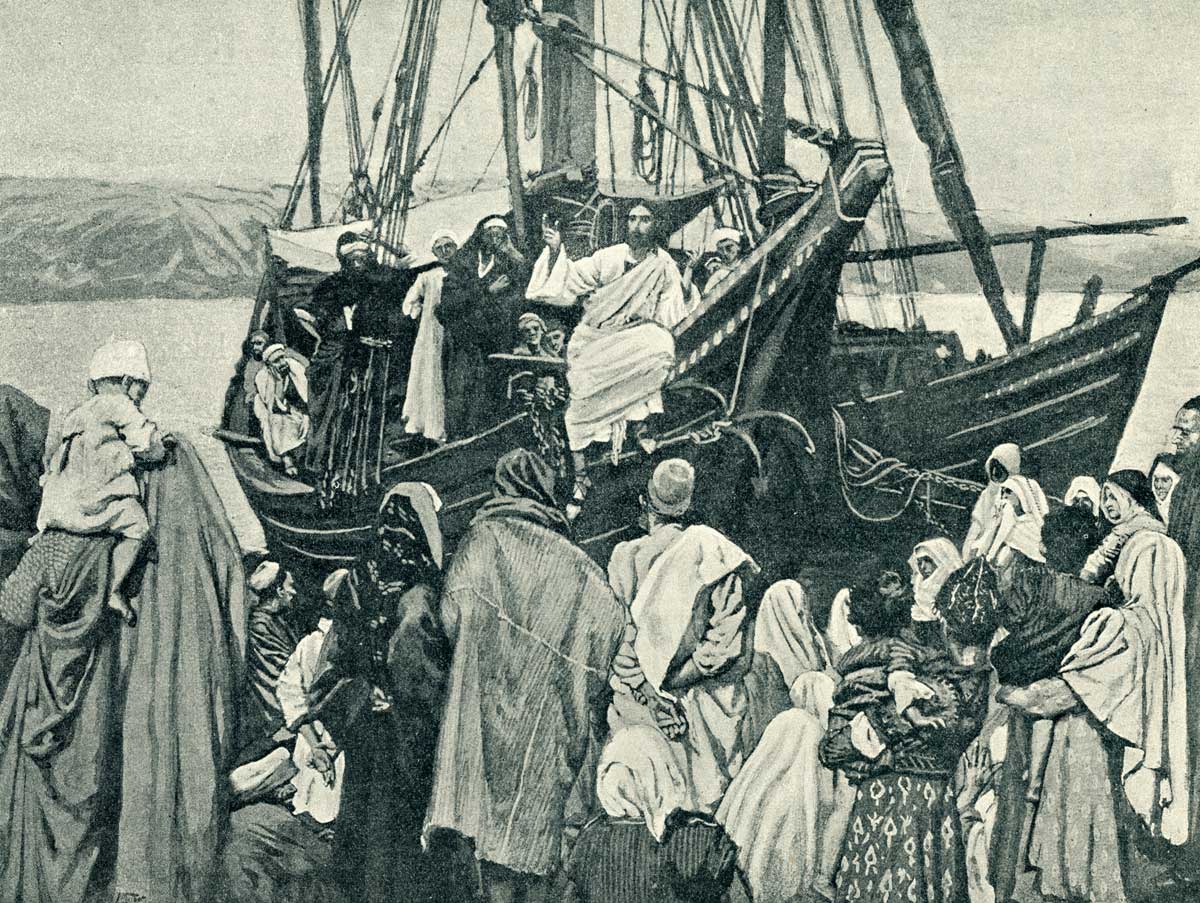Lessons & Carols
Rod Dreher on Finding Hope in Difficult Times
Winter in New York City is cold and hard, but next to our glorious autumns, it is my favorite time of the year, because it snows here. We have not seen many snowy days the past few winters, at least compared to the city’s usual amount, but as a child who grew up in snow-free southern Louisiana, hoping against hope for a white Christmas (or a white any day), snowflakes are like manna from heaven.
This past December New York had a glorious early-season snow day. The snow began before daylight and came down heavily all day. My wife and I took our three-year-old son out sledding along the sidewalks of Brooklyn, where everyone was being unusually cheerful and kind to each other. It was especially wonderful after the sun went down and the streetlights went on, causing the sidewalks to glow, or so it appeared.
A Sign of Rebirth
The three of us bundled up and took the subway over to downtown Manhattan to Battery Park for an a cappella concert and tree-lighting ceremony. Battery Park City is the name of the neighborhood built on top of land added to the western tip of Manhattan island from the earth excavated when the World Trade Center was built.
On September 11, 2001, the people of Battery Park City found themselves living on the lip of a volcano. They suffered tremendously on that day, and for a long time after. The lighting of a Christmas tree in Battery Park this past December was to be a sign of rebirth. My wife and I planned to go to hear the Roches, three sisters who sing a cappella, perform Christmas music. Their Christmas album, long out of print, was a favorite of ours when we were younger, so hearing the Roche sisters perform live was a rare New York treat for us.
After emerging from the subway into downtown Manhattan, we stopped by Ground Zero to say a prayer. You might remember the Brooks Brothers store directly across from the south tower; on 9/11, it served as a makeshift morgue. Rescuers stacked recovered body parts in its aisles. Now the store windows were filled with red ribbons, greenery, and Christmas merchandise, bathed in warm light. It almost made me weep to see that mundane resurrection.
I stood across the street, at the fence ringing the site, and noticed the large steel-beam cross on its pedestal, its arms holding up a thin layer of snow. Just beyond it, someone had put up a huge Christmas tree, which would in days be festooned with lights, and hymned by choirs, but which tonight was merely evergreen. A sign of life. I offered my prayers for the dead, then turned away and walked back to where my wife and son were standing. A man in a trenchcoat hustled off making some kind of noise. Julie pointed to him, with a look of astonishment on her face.
“Did you hear that?” she asked. No, I hadn’t. “He was a businessman, I think, and he was singing Ave Maria at the top of his lungs as he passed the site.”
On we went to Battery Park, on the banks of the Hudson. Julie and I laughed when we first stepped into the park, where the snow lay like frosting on tree branches. Before us was a winter wonderland worthy of a Christmas card or a department-store window display. As we approached the loose knot of people gathered around the corner of a building, the Roches had just begun the “Hallelujah Chorus” in three-part harmony. We got hot chocolate and Christmas cookies, and stood under trees in our boots listening to these sisters sing the most beautiful versions of sacred and secular carols I’ve heard in ages.
The snow was still falling on the dark waves of the Hudson, and my boy told me he wanted to cross over to Jersey. “That’s where Edison lives,” he said. But we stood in the snow with the neighborhood folks, listening to the music, with hearts full of gratitude for this city and our place in it. A little over a year ago, on that terrible day, this neighborhood was covered with ash, and choked by smoke from the inferno a few blocks away.
Tonight, though, thanks to the cold and the snow, everything was clean and white and crystalline-pure. Watching the children in their wool caps laughing and eating peppermint canes and throwing snowballs at each other, I thought about how terrified they must have been on 9/11, and wondered if they and their parents ever thought their neighborhood would see a night so serene and joyous as this one.
Going Through the Motions
I thought too about how hard it had been for me to feel the warmth, camaraderie, high spirits, and joyful expectation I had always felt at this time of year. Last year I felt as if I were only going through the motions, because the trauma of the 9/11 attacks was too fresh. It is hard to feel much joy when smoke from the de facto crematorium across the river still lurks in your streets when the wind blows out of the west.
Time had healed a lot of the pain from the attack, but new wounds had been opened, at least for Catholics like me. The sex-abuse scandal had tested my faith like nothing in my experience. I had watched as some of our priests were revealed to have preyed upon children, and many of our bishops were shown to have aided and abetted the rape of the most innocent and vulnerable of their flocks.
I learned through my work as a journalist that the corruption in the Church is much deeper than I or anyone else has been able to report—yet. But the stories will be told, because more documents will be released, and victims and witnesses to this evil (I am speaking of priests and church employees) will lose their fear of speaking the unspeakable. If 2002 was a bad year for the Catholic Church, just wait for 2003.
And yet it has been a good year for the Church, in the most important sense. This agony is a purification, a withdrawal from a spiritual and moral corruption that has been destroying the health and integrity of the Body of Christ. I have found Catholic men and women in whose judgment I had trusted to have feet of clay, and found others—church liberals—to whom I had not given more than token respect to have been not only right about some important things but also courageous in speaking out at a time when orthodox Catholics like me and my friends preferred not to see what was happening around us.
All Catholics who love their Church can agree that we arrived in Advent battered and discouraged. It was difficult for me to see the holiness of the Church amidst the filth of the scandal. In December, I was thinking about this all the time, and carried within me a heavy heart, a sorrowful and anxious burden I even felt that snowy night with my family in Battery Park.
And then I saw something that delivered me from thoughts of Cardinal Bernard Law and all the pomps and works of the American bishops.
As the Roche sisters sang, I noticed an older man, maybe a businessman, attending an older woman in a wheelchair. She must have been his wife. She was wrapped snugly in a gray shawl, her thin face swaddled by a red scarf. Her face looked so forlorn and expressionless, I thought she must be depressed. Then he brought her a Christmas cookie, and she brought her right hand out from under the shawl to take it. Her hand shook violently, and she labored to bring the cookie to her mouth. Parkinson’s. This would account for the frozen expression on her face.
From that moment, it was hard to take my eyes off the couple. The old man was so tender with his wife, fussing to see that she had what she needed, that she was warm, that she felt the touch of his hand. When the Roches began to sing O Holy Night, the old man knelt in the snow, placed his face on his wife’s shoulder, and softly sang the words to her. I could read his lips. His bright eyes brimmed with love and mercy, hers stared into the distance. “O night! O night divine!” they sang, the sisters for the gathered neighbors, and the old man for his wife.
Comfort & Joy
“A thrill of hope,” the song went, and I thought of these New Yorkers who did not leave the city, but who stayed to rebuild and renew their neighborhood, and indeed their broken hearts. I thought of the Cross and the Christmas tree at Ground Zero, and the simple act of commerce at Brooks Brothers, new life where there had once been nothing but smoke and flames and death.
Most of all, I thought of this gentle soul, sharing the cup of suffering with his true love, trying to bring her warmth and consolation and joy. Everyone there has lived through or is living through pain and destruction, and yet here they were, on a magnificent winter’s night, making something beautiful for God.
There is not enough evil in the world to extinguish the good in the hearts of men. The light shines in the darkness, and the darkness did not overcome it.
Rod Dreher is a contributing editor to Touchstone. He is a writer and blogger and the author of several books, including The Benedict Option (2017) and Live Not by Lies: A Manual for Christian Dissidents (2020).
subscription options
Order
Print/Online Subscription

Get six issues (one year) of Touchstone PLUS full online access including pdf downloads for only $39.95. That's only $3.34 per month!
Order
Online Only
Subscription

Get a one-year full-access subscription to the Touchstone online archives for only $19.95. That's only $1.66 per month!
bulk subscriptions
Order Touchstone subscriptions in bulk and save $10 per sub! Each subscription includes 6 issues of Touchstone plus full online access to touchstonemag.com—including archives, videos, and pdf downloads of recent issues for only $29.95 each! Great for churches or study groups.
Transactions will be processed on a secure server.
more on Christmas from the online archives
more from the online archives
calling all readers
Please Donate
"There are magazines worth reading but few worth saving . . . Touchstone is just such a magazine."
—Alice von Hildebrand
"Here we do not concede one square millimeter of territory to falsehood, folly, contemporary sentimentality, or fashion. We speak the truth, and let God be our judge. . . . Touchstone is the one committedly Christian conservative journal."
—Anthony Esolen, Touchstone senior editor













